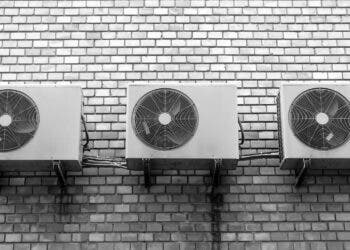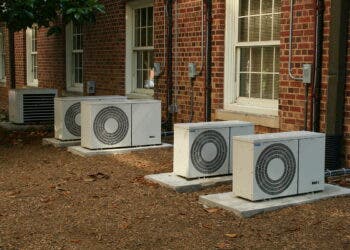As Russian forces continue to attack Ukraine, European countries are trying to rid themselves of their need to use Russian oil and gas — but it’s not proving easy. In Italy, air conditioning is now at the forefront of the debate in Italy after Prime Minister Mario Draghi used air conditioning as an example of something Italians might have to sacrifice in return for peace in Ukraine. “Do we want to have peace or do we want to have the air conditioning on?” he said earlier this month.
Starting next month, schools and public buildings in Italy will be banned from setting the air conditioning to below 25ºC in summer and beyond 19ºC in winter. The measure will be applicable until 31 March next year but could be further extended. It’s intended to help the country deal with an energy crisis now worsened by the war in Ukraine.

The initiative has been called “Operation Thermostat” and will start in two weeks. It’s not fully clear yet how the government will enforce it, though. Local media has suggested inspectors from the Ministry of Labor could do the controls, imposing fines between 500 and 3,000 euros. The plan could be also extended to private homes — but the logistics of truly checking whether the rule is respected seem very challenging.
But the measure could have a significant impact, reducing Italy’s fossil fuel use.
Renato Brunetta, the minister for public administration, told local media that the country could save between two and four billion cubic meters of gas a year thanks to the new plan. That translates to 7-14% of the total natural gas that Italy used to import from Russia. Angela Masi, a politician with the Five Star Movement, said the public administration should be setting the example and raising awareness among citizens.
Italy currently gets some 40% of its gas imports from Russia and has been looking to diversify its energy supplies since Russia’s invasion. The government has already signed deals with Angola, Algeria, Egypt, and Qatar to ramp up gas supplies, as well as approved a four billion package to help consumers and firms cope with energy costs.
The package is funded by taking extra profits from energy companies that benefited from the rising energy prices and won’t alter the public deficit, the government said. “We have taken important and motivated measures to respond to the consequences on our country of the war in Ukraine,” Draghi told a news conference last week.
Russia’s energy crisis
Russia’s unprovoked invasion of Ukraine has shaken the energy markets, driving oil and gas to their highest levels in almost a decade and forcing many countries, such as Italy, to reconsider their energy supplies. Russia is a major oil exporter and it’s the leading supplier of natural gas to the European Union (EU).
This is not the first time a military action from Russia has raised concerns about energy security. The same happened in 2008 when Russia invaded Georgia and in 2008 and in 2014 when it invaded and then annexed the territory of Crimea, in Ukraine. But this time feels different, with the US and the EU announcing plans to truly stop buying Russian fuels.
The biggest question is how to actually do that. The US and the UK were the first ones to ban Russian oil, but neither depend much on these imports, so it was an easy target. The EU as whole imports around 40% of its natural gas and a quarter of its oil from Russia. But that could change soon as countries implement a new plan to diversify energy sources.
The European Commission (EC) recently published a plan to reduce imports of Russian gas by about two-thirds by the end of the year. The strategy relies on increasing imports of natural gas from abroad. The EC is already discussing with existing gas suppliers such as Norway and Algeria the possibility of increasing flows soon.
Energy and air conditioning
The shift from Russian oil and gas is seen by many as an opportunity to try and truly make Europe greener. Cutting down on air conditioning is a step in the right direction.
Air conditioning is a poignant challenge when it comes to global warming. It’s not exactly a necessity (at least most of the time), and it uses up a lot of energy, which produces greenhouse gas emissions. But the more the world warms, the more we will need cooling. Not just for comfort, but also for health and survival in many parts of the world. This means growing energy consumption and more emissions released — a vicious cycle that’s hard to escape.
According to the “Future of Cooling” report, the number of air conditioning units could triple worldwide by midcentury – pushing the total close to six billion. Without major tech improvements, this would also triple energy demand from cooling, reaching 6,200 terawatt-hours by 2050, or a quarter of the world’s total energy consumption today.
The report found there’s been little funding flowing into the air conditioning sector, with few advances in products in the market. The technology operates much as it did when it was introduced a century ago. This doesn’t make much sense when we think of improvements in other energy technologies such as solar panels and batteries.
But even if the global stock of air conditioning becomes more efficient, the projected increase in usage is so large that electricity demand will still soar. This further complicates the task of cleaning up the world’s power sector. For the authors of the report, the best way forward is transitioning to a larger use of clean energy sources.
There are also ways to reduce electricity loads required to cool buildings, such as installing window coverings, sealing air leaks, applying reflective colors on rooftops, and adding insulations. A study last year found creating cool rooks in 80% of commercial buildings in the US would cut annual energy use by over 10 terawatt-hours.






